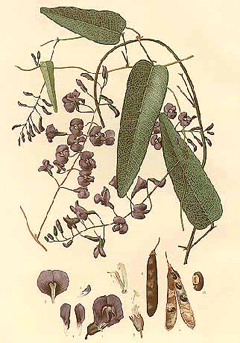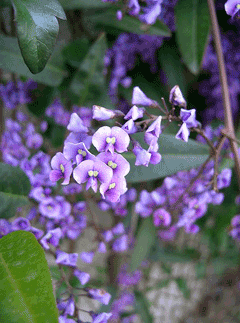 |
|
|
 |
| http://commons.wikimedia.org/wiki/User:KENPEI |
Translate this page:
Summary
Bloom Color: Purple. Main Bloom Time: Early spring, Late winter, Mid spring. Form: Prostrate.
Physical Characteristics

 Hardenbergia violacea is an evergreen Climber growing to 2 m (6ft 7in) at a fast rate.
Hardenbergia violacea is an evergreen Climber growing to 2 m (6ft 7in) at a fast rate.
See above for USDA hardiness. It is hardy to UK zone 9 and is frost tender. It is in leaf all year, in flower from March to April. The species is hermaphrodite (has both male and female organs) and is pollinated by Insects.
It can fix Nitrogen.
Suitable for: light (sandy), medium (loamy) and heavy (clay) soils and prefers well-drained soil. Suitable pH: mildly acid and neutral soils. It can grow in semi-shade (light woodland) or no shade. It prefers moist soil.
UK Hardiness Map
US Hardiness Map
Synonyms
H. monophylla. Kennedya monophylla. K. ovata.
Plant Habitats
Woodland Garden Sunny Edge; Dappled Shade; South Wall. By. West Wall. By.
Edible Uses
Edible Parts:
Edible Uses: Drink
The boiled leaves produce a slightly sweet and reasonably pleasant drink[144, 183]. At one time the roots were also reportedly used for this purpose[183].
References More on Edible Uses
Medicinal Uses
Plants For A Future can not take any responsibility for any adverse effects from the use of plants. Always seek advice from a professional before using a plant medicinally.
None known
References More on Medicinal Uses
The Bookshop: Edible Plant Books
Our Latest books on Perennial Plants For Food Forests and Permaculture Gardens in paperback or digital formats.

Edible Tropical Plants
Food Forest Plants for Hotter Conditions: 250+ Plants For Tropical Food Forests & Permaculture Gardens.
More

Edible Temperate Plants
Plants for Your Food Forest: 500 Plants for Temperate Food Forests & Permaculture Gardens.
More

More Books
PFAF have eight books available in paperback and digital formats. Browse the shop for more information.
Shop Now
Other Uses
References More on Other Uses
Cultivation details
Landscape Uses:Arbor, Container, Specimen. Requires a moist well-drained lime-free soil in sun or light shade[200]. This species is not very hardy in Britain, tolerating temperatures that occasionally fall to about -5°c[260]. It succeeds on a wall in Cornwall, mixing well with Passiflora species through which it intertwines[1, 166]. Plants from the Tablelands in Australia tolerate at least -7°c in Australian gardens[157]. This cannot be translated directly to British gardens, however, due to our cooler summers and longer, colder and wetter winters[K]. Any pruning is best carried out immediately after the plant has flowered[219]. This species has a symbiotic relationship with certain soil bacteria, these bacteria form nodules on the roots and fix atmospheric nitrogen. Some of this nitrogen is utilized by the growing plant but some can also be used by other plants growing nearby[200].
References Carbon Farming Information and Carbon Sequestration Information
Temperature Converter
Type a value in the Celsius field to convert the value to Fahrenheit:
Fahrenheit:
The PFAF Bookshop
Plants For A Future have a number of books available in paperback and digital form. Book titles include Edible Plants, Edible Perennials, Edible Trees,Edible Shrubs, Woodland Gardening, and Temperate Food Forest Plants. Our new book is Food Forest Plants For Hotter Conditions (Tropical and Sub-Tropical).
Shop Now
Plant Propagation
Scarify the seed or pre-soak it for 24 hours in warm water[157, 200]. Sow spring in a warm greenhouse at 20°c[200]. When they are large enough to handle, prick the seedlings out into individual pots and grow them on in the greenhouse for at least their first winter. Plant them out into their permanent positions in late spring or early summer, after the last expected frosts. Give the plants some protection from the cold for at least its first winter outdoors. Cuttings of half-ripe wood, July/August in a frame. Tip cuttings, taken in late spring, in moist sand in a frame[200].
Other Names
If available other names are mentioned here
Native Range
AUSTRALASIA: Australia (Tasmania (east), New South Wales (e. & c.), Queensland (southeast), South Australia (south), Victoria (south))
Weed Potential
Right plant wrong place. We are currently updating this section.
Please note that a plant may be invasive in one area but may not in your area so it's worth checking.
Conservation Status
IUCN Red List of Threatened Plants Status :

Growth: S = slow M = medium F = fast. Soil: L = light (sandy) M = medium H = heavy (clay). pH: A = acid N = neutral B = basic (alkaline). Shade: F = full shade S = semi-shade N = no shade. Moisture: D = dry M = Moist We = wet Wa = water.
Now available:
Food Forest Plants for Mediterranean Conditions
350+ Perennial Plants For Mediterranean and Drier Food Forests and Permaculture Gardens.
[Paperback and eBook]
This is the third in Plants For A Future's series of plant guides for food forests tailored to
specific climate zones. Following volumes on temperate and tropical ecosystems, this book focuses
on species suited to Mediterranean conditions—regions with hot, dry summers and cool, wet winters,
often facing the added challenge of climate change.
Read More
Expert comment
Author
(Schneev.)Stearn.
Botanical References
200
Links / References
For a list of references used on this page please go here
Readers comment